Digital done differently.
Modeling done flawlessly.
Casio’s phase distortion synthesis was a relative of FM but simpler to use, achieving patches that sounded both ‘digital’ and ‘analog’ with equal ease.
It became a sonic staple for artists including Eurythmics, Salt-N-Pepa, and Vince Clarke (Depeche Mode, Yaz, Erasure), who famously stacked up eight CZ-101 synths and a sequencer. CZ V gives you more of what the CZ was loved for in every way – and more.
Expertly Engineered
Our DSP crew reverse-engineered the core code of the CZ, then added features to make phase distortion even more compelling today.
Shockingly Flexible
The CZ series is used on all kinds of songs because it produced so many sounds so well. Let CZ V do the same for you.
CZ = EZ
Wringing a ton of sonic range out of just a handful of parameters, CZ V is one of the quickest paths from a sound in your head to sound in your speakers.
Turbocharged
We amped up the CZ with up to 32 voices of polyphony, four FX slots, eight envelopes, and everything but a flux capacitor.
More than just
a phase
The CZ-101 defined a whole new way of creating the sounds keyboardists and producers wanted. This put Casio® on the map as a maker of serious professional synthesizers. CZ V puts phase distortion back on the map with the ultimate version of this groundbreaking synthesis technology.
In the early ’80s, Casio wasn’t about to sit still while the DX7 took over the world. Fortunately, they had a platform to build on — a high-end synth workstation called Cosmo. It’s the direct ancestor of the CZ-101, whose mini keys and $499 price tag put real synthesis in the hands of a new generation of musicians.
Discover the history of CZ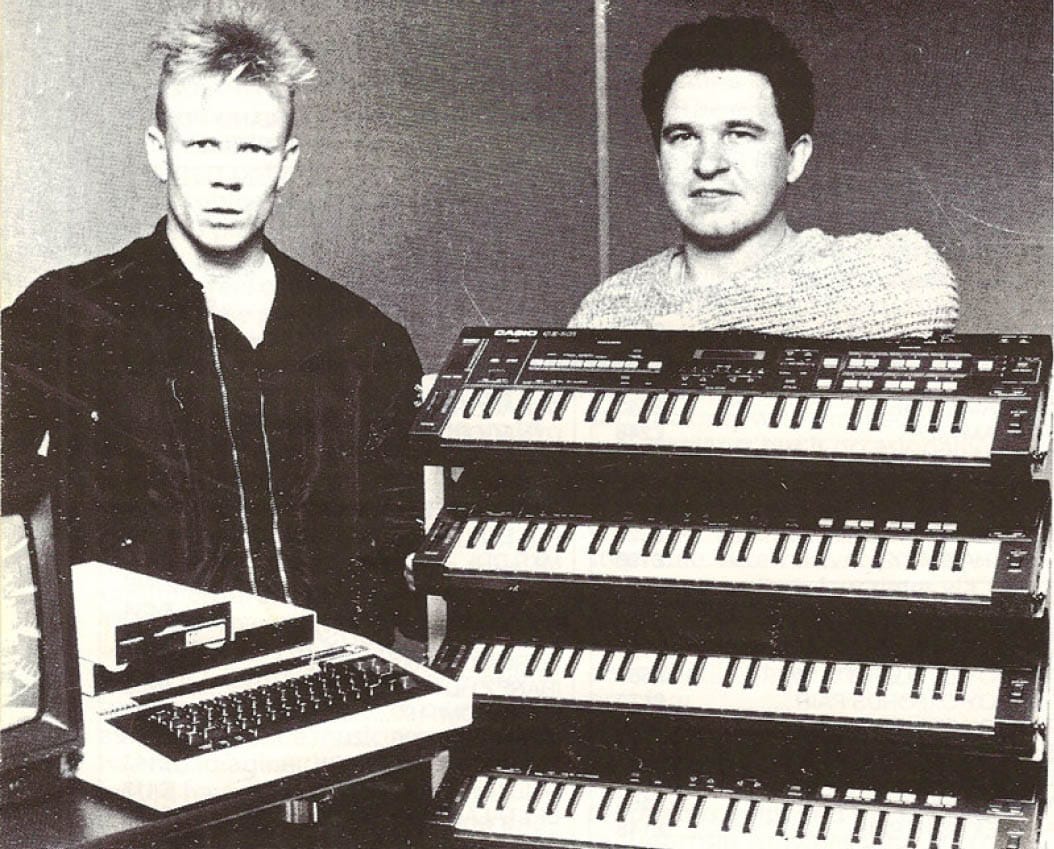
Originally designed for Isao Tomita, the Cosmo was Casio’s foray into Synclavier and Fairlight territory. While not a commercial success, this server rack worth of sampler and synth units served as the proving ground for phase distortion (PD), a technique pioneered by Casio engineer Mark Fukuda.
Where FM modulated the frequency of one waveform with another, PD altered the carrier wave’s time domain. By varying the modulation amount, you could go from a sine wave to tones full of rich harmonics. You weren’t confined to sine waves as on the DX family; modulator waves (and thus the waveform you hear) could morph from simple to complex — duplicating analog waves and a lot more.
Released in 1984, the CZ-101 featured two “Lines," each with its own envelopes for pitch, modulation amount, and volume. Using one Line yielded eight voices of polyphony; two cut that to four voices. Some modulations mimicked a resonant filter, which eliminated the need for a costly analog circuit. Importantly, users found the relationship between tweaking this or that control and a given sonic result more intuitive than the multi-operator structure of the DX7.
Follow-up models included the full-sized CZ-1000 (1985); the CZ-3000, which doubled the polyphony; the CZ-5000 with its 8-track sequencer; and the flagship CZ-1 (1986), featuring a velocity- and aftertouch-sensitive keyboard. Then there’s CZ V, which removes all limitations of hardware and proves that phase distortion synthesis itself has no limits either.
A different kind of
of distortion
Phase distortion, like FM, involves one oscillator modulating another.
Phase distortion's uniqueness comes into play by altering the time domain of the carrier wave, yielding a different oscillator wave shape entirely. By changing the linearity of how a simple waveform plays, like speeding up the start of the cycle, it’s no longer a simple waveform. That’s the concept at the heart of phase distortion synthesis and CZ V’s sound.
DCO > DCW > DCA
Each DCO in CZ V lets you select from the 8 original waveforms or draw your own. Some serial combinations of two different waveforms are provided for, resulting in many more possibilities. Each DCO is followed by a corresponding digitally controlled waveshaper (DCW) section, including key follow and an 8-stage envelope generator. This animates the amount of waveshaping from the modulator over time. There’s also an eight-stage envelope for DCO frequency, allowing for pitch-change effects far beyond vibrato, trills and lasers. A digitally controlled amplifier (DCA) with its own eight-stage envelope rounds out a DCO>DCW>DCA signal chain roughly equivalent to that of analog VCO>VCF>VCA.
Between the lines
Like the original, the CZ V has two complete DCO>DCW>DCA signal lines that you can use individually or in parallel. Duplicate settings in each line allows for a fatter sound given the ability to transpose and/or detune them, while separate settings provide for much more complex timbres. You might, for example, shape a hyper-percussive sound in one line and craft a pad in the other to combine into a compound timbre. Other goodies faithful to the original include a dedicated vibrato section, polyphonic portamento, ring modulation and noise modulation.
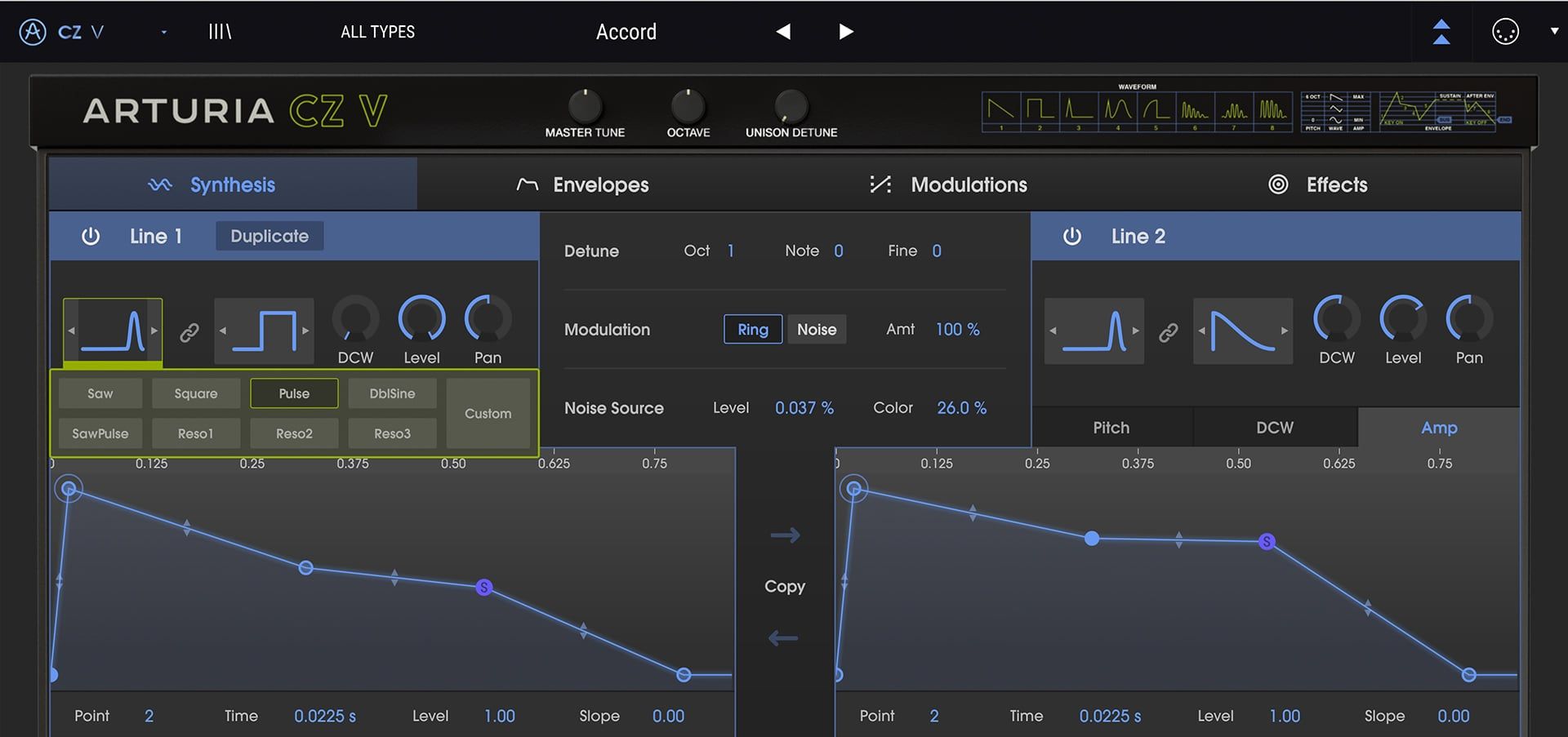
Simple Synthesis
Ultimately, the beauty of PD compared to the better-known FM is that there are only four primary things that really control the timbre of each CZ line: the DCO’s modulating waveform and the three envelopes. Both PD and FM have made significant and instantly recognizable contributions to music, but the simpler concept of PD can ironically get a lot closer to analog bass, brass, strings and more with a lot less fiddling.
Our DSP team reverse-engineered the code inside the CZ-series and even modeled the DAC outputs, delivering the perfect combination of authentic PD behavior and that crunchy, almost-lo-fi sound of the ‘80s, right in your DAW.
A CZ for
Today
The CZ-101 had an instant and intuitive interface, especially for an early digital synth - yet CZ V is quicker and more performance-oriented in every way.
Everything you need for breathtaking tracks and gig-ready sounds is arranged for maximum connection between thoughts, hands, and music.
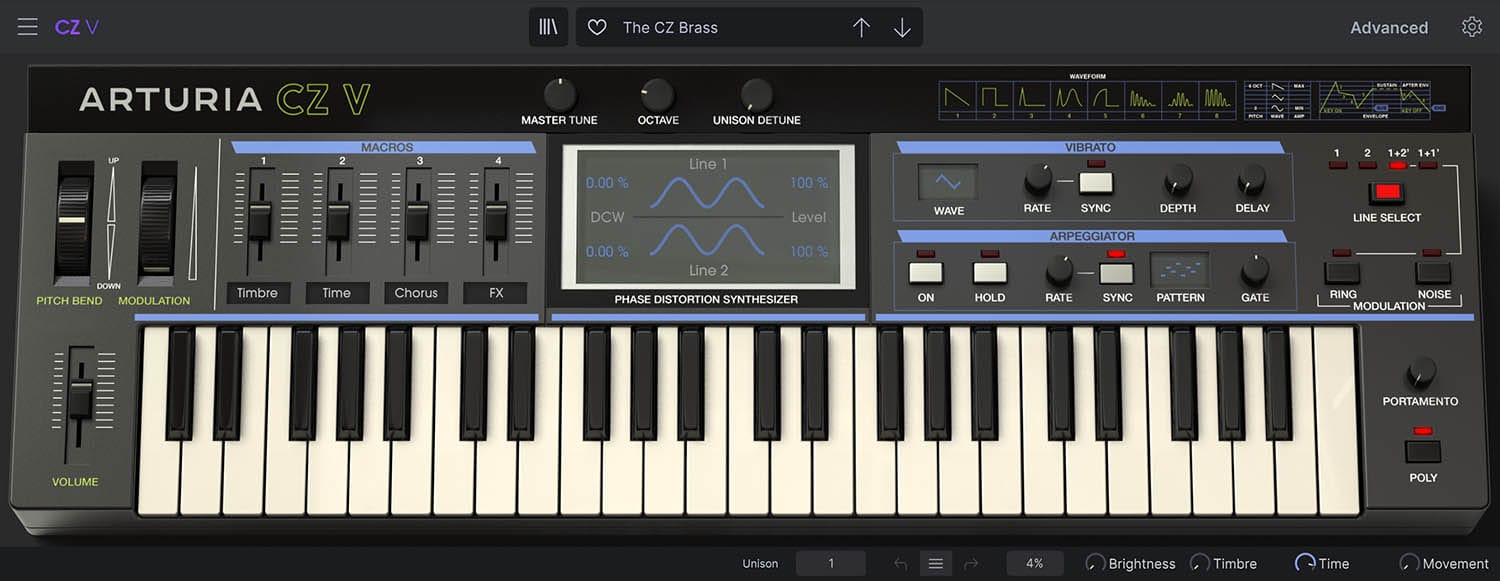
_1
_2
_3
_4
_5
_6
01. Eyes Meet Ears
See exactly what’s happening to your sound as you play and the waveforms morph, right in the central display area.
02. Drop the Bass, Tweak the FX
Four sliders can each control multiple parameters at once for performance gestures from subtle to drastic.
03. Dedicated Vibrato
We’ve upgraded the CZ’s stand-alone vibrato section with more waveforms, tempo sync, and adjustable delay.
04. Guilty Pleasure Generator
What would an ’80s synth be without a classic arpeggiator? Ours features six patterns (including as-played and random) and up to a 4-octave range.
05. Line Up
Choose to hear Line 1, Line 2, both, or Line 1 plus a copy of itself. Then, ring- or noise-modulate them here.
06. Poly or Mono
Toggle into mono mode for thick unison leads on solos, then back to poly for playing chords, with one button.
A CZ for
Tomorrow
Massive synthesis power lurks just beneath the surface in CZ V’s Advanced Panel. We’ve made all of it fun and easy to use.
If this much capability had been packed into hardware, phase distortion might have become the dominant synthesis method in music. Our Advanced interface makes it more intuitive than ever to see just how far PD can go.
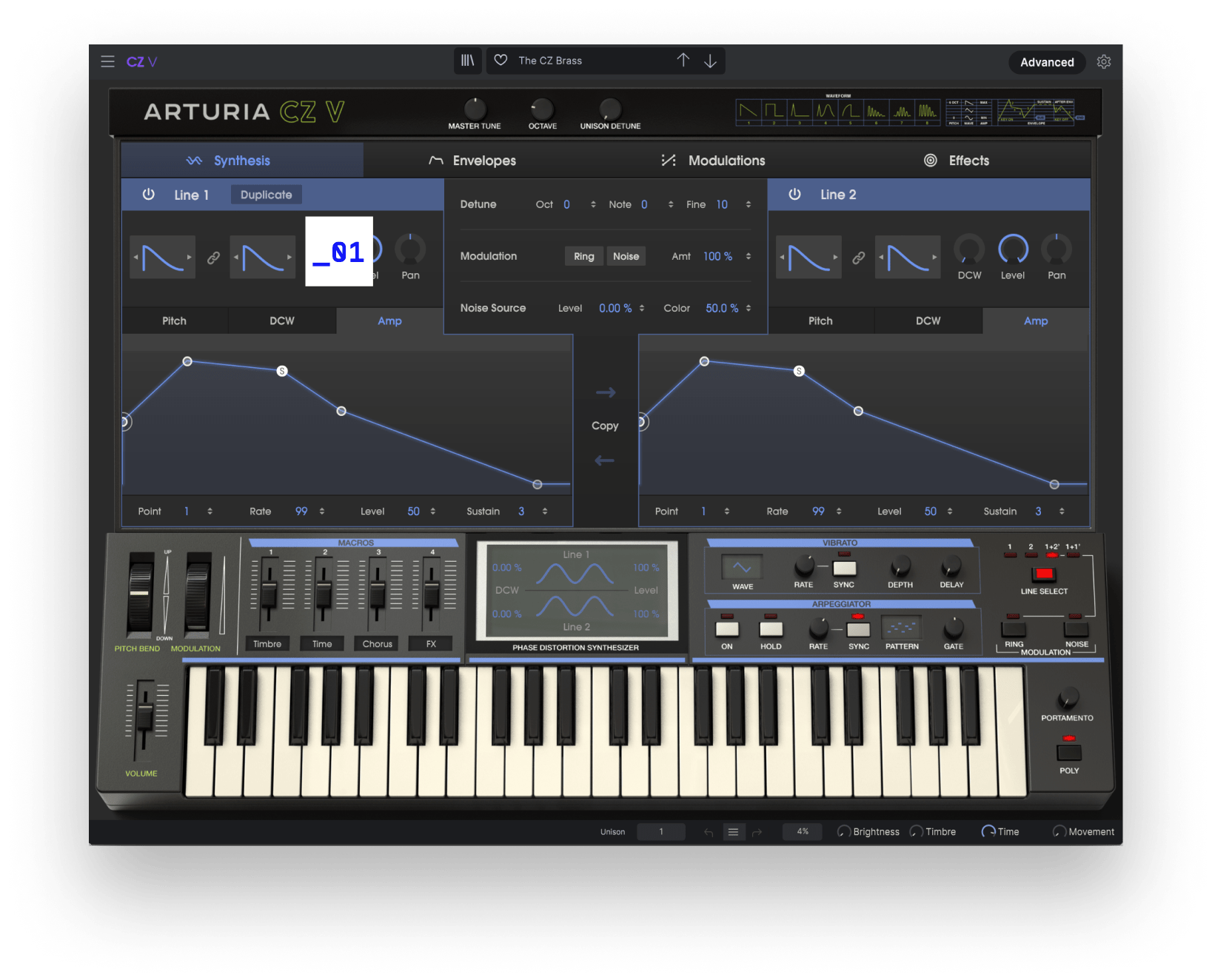
With different target waveforms for the first and second cycle in each Line, creating ear-grabbing harmonic motion is a snap!
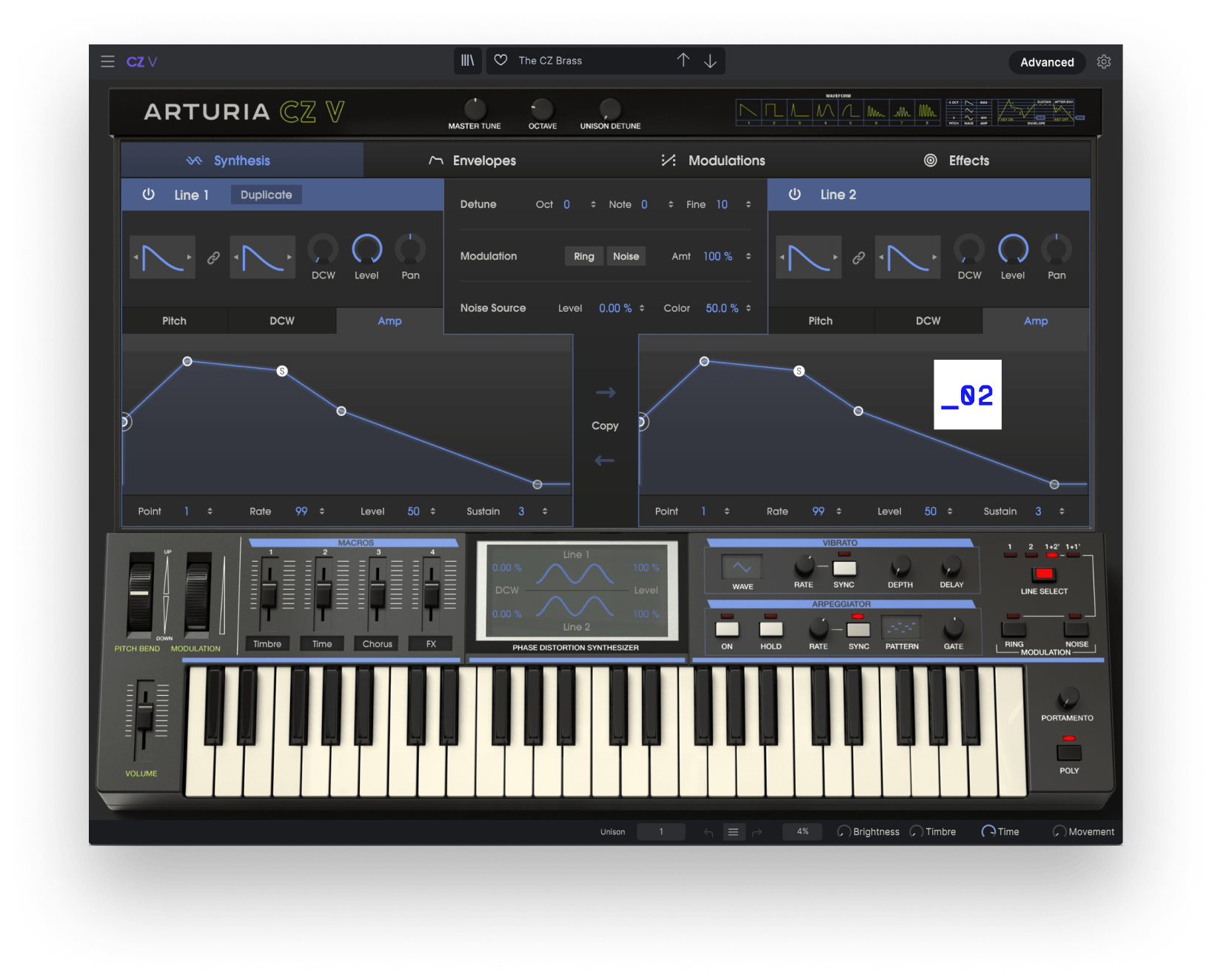
CZ V duplicates the hardware’s eight waveform choices, but if you want something different, just draw and save your own to produce any sound imaginable.

Separate envelopes for pitch, PD amount (DCW), amp, and modulation for each Line power sounds that move, evolve, and interweave.
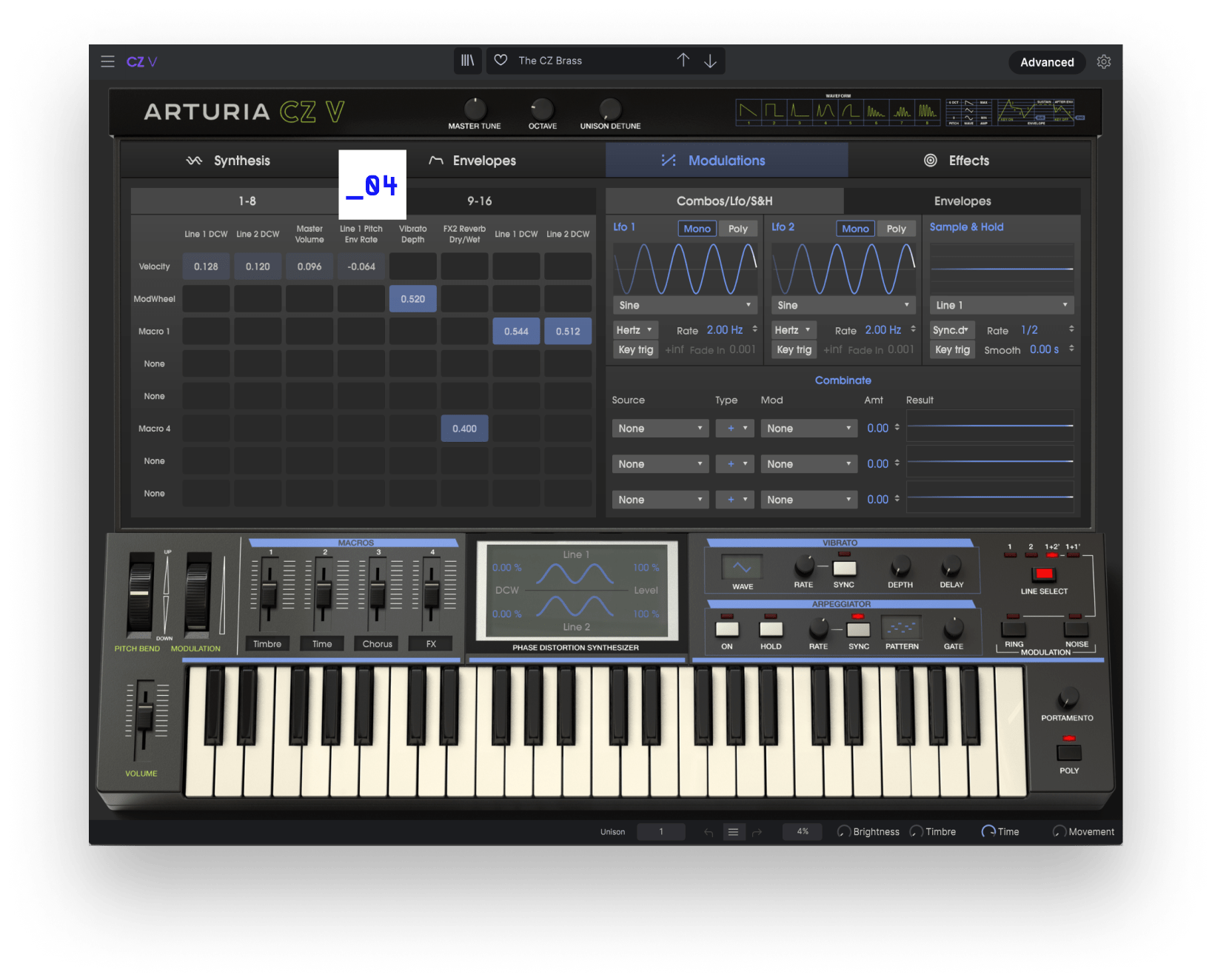
Assign multiple sources including the Macro sliders to a staggering number of destinations here — no hardware CZ had this many modulation options.
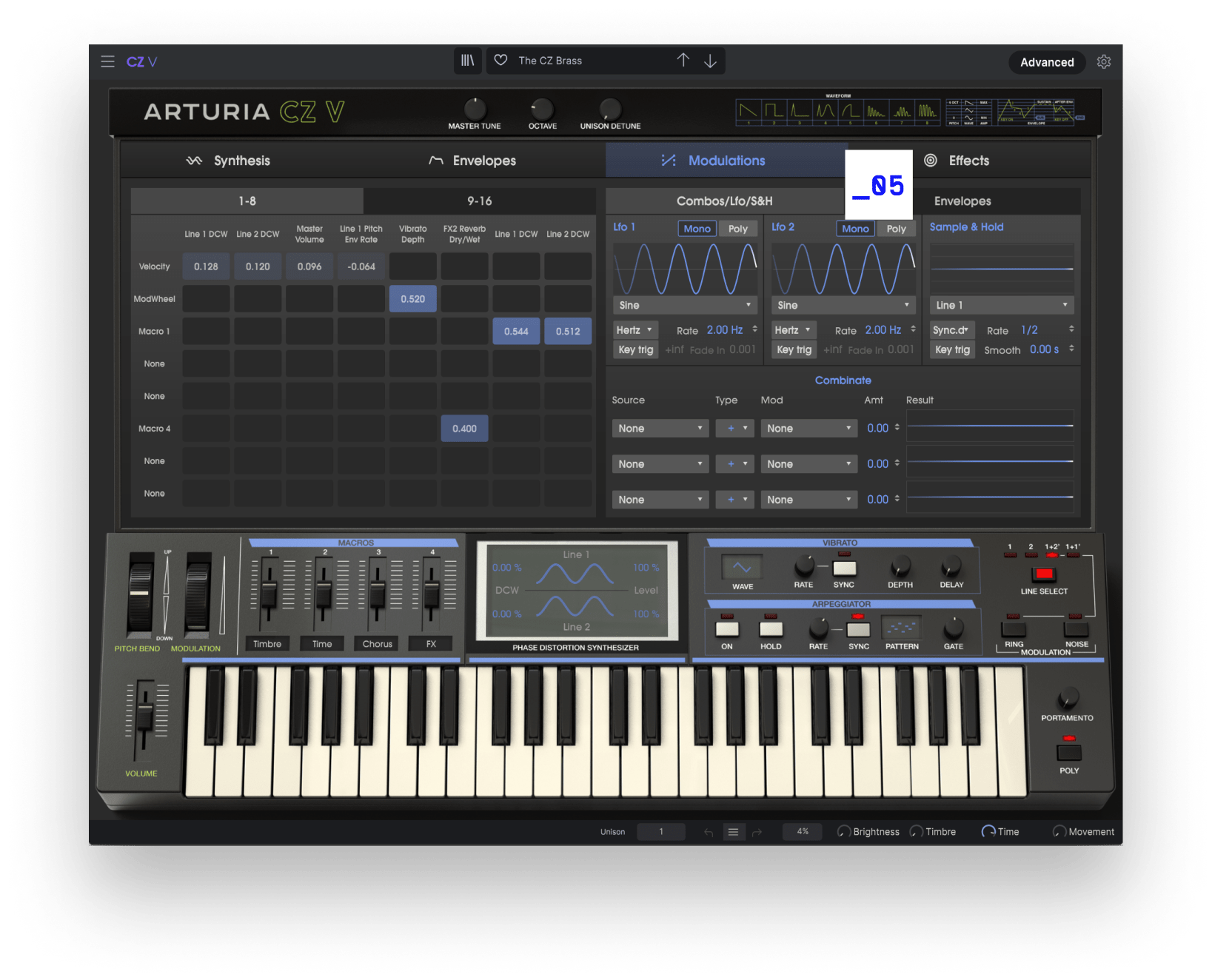
We added assignable LFOs and envelopes. Then, blend any two modulation sources into something completely different using the Combinator slots.
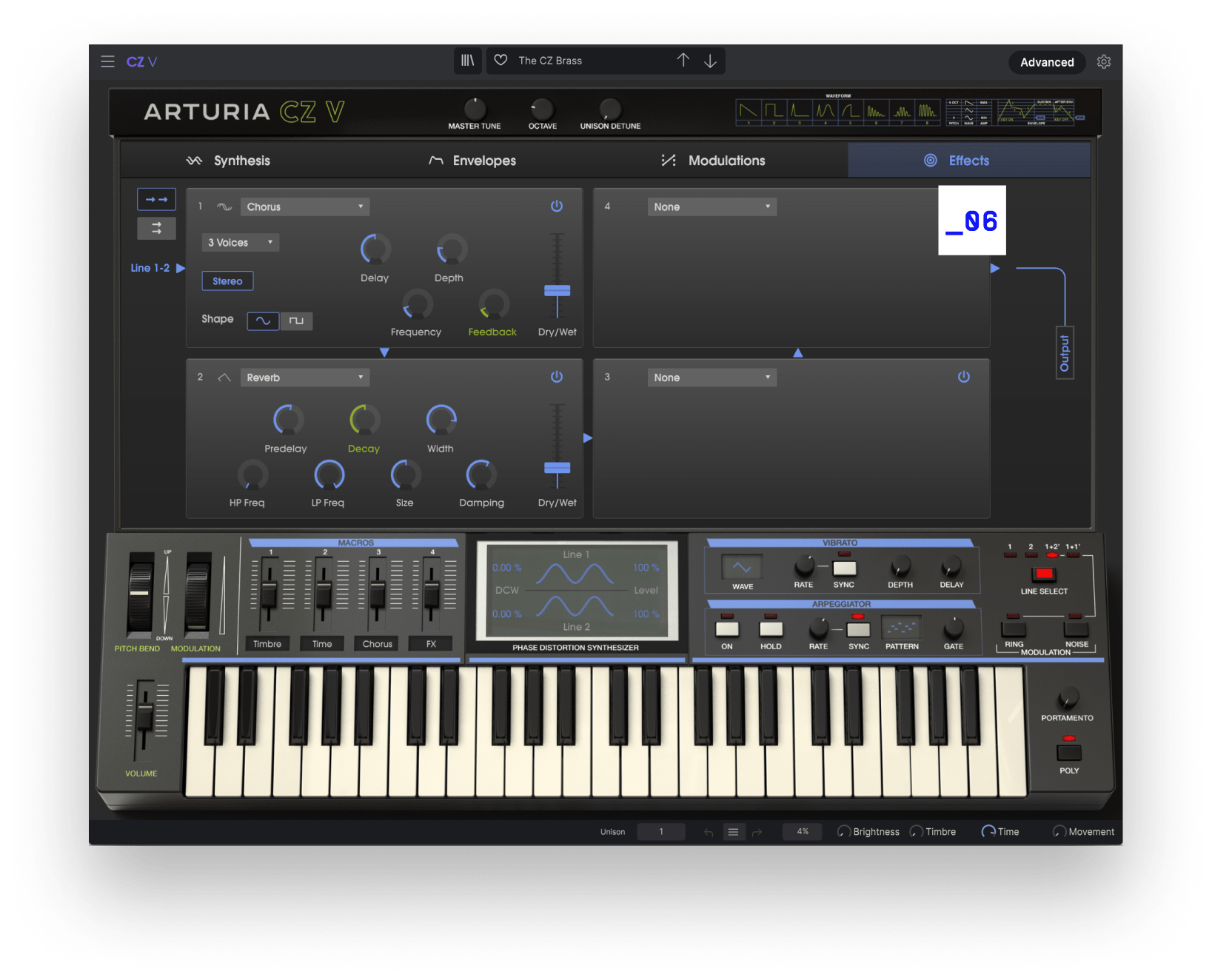
Run Lines 1 and 2 in series or parallel through studio-quality effects. Missing that analog-style synth filter? It’s here!
Hear it
in action
Could someone do an entire album using just CZ V sounds?
Listen to these audio demos from prominent artists and sound designers and judge for yourself. (Hint: We think so!)
Chunky House
Thomas Koot
Cinematic
New Loops
DrumBass Desires
JMB
Lost Land
Don Solaris
Mouvances
Paul Schilling
Nostalgia
Cubic Spline
SlowCore
Cubic Spline
Trance
Thomas Koot
Tropical Serenade
Lily Jordy
Presets
CZ V is surprising because it can sound like an analog synth.
It can sound like a DX. It can sound like a PPG Wave. It can generate evocative pads and choirs. And much more. Check out some select highlights from its built-in library of 500+ presets.
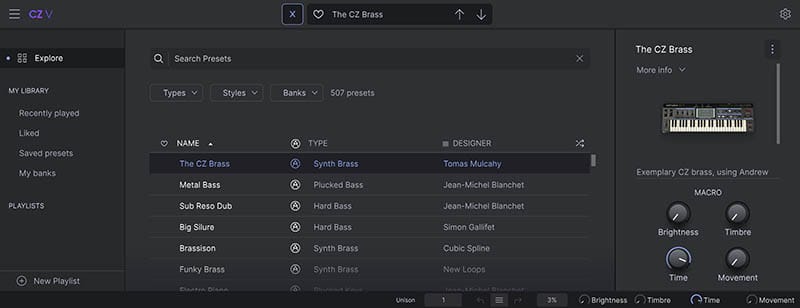
Artistscorner
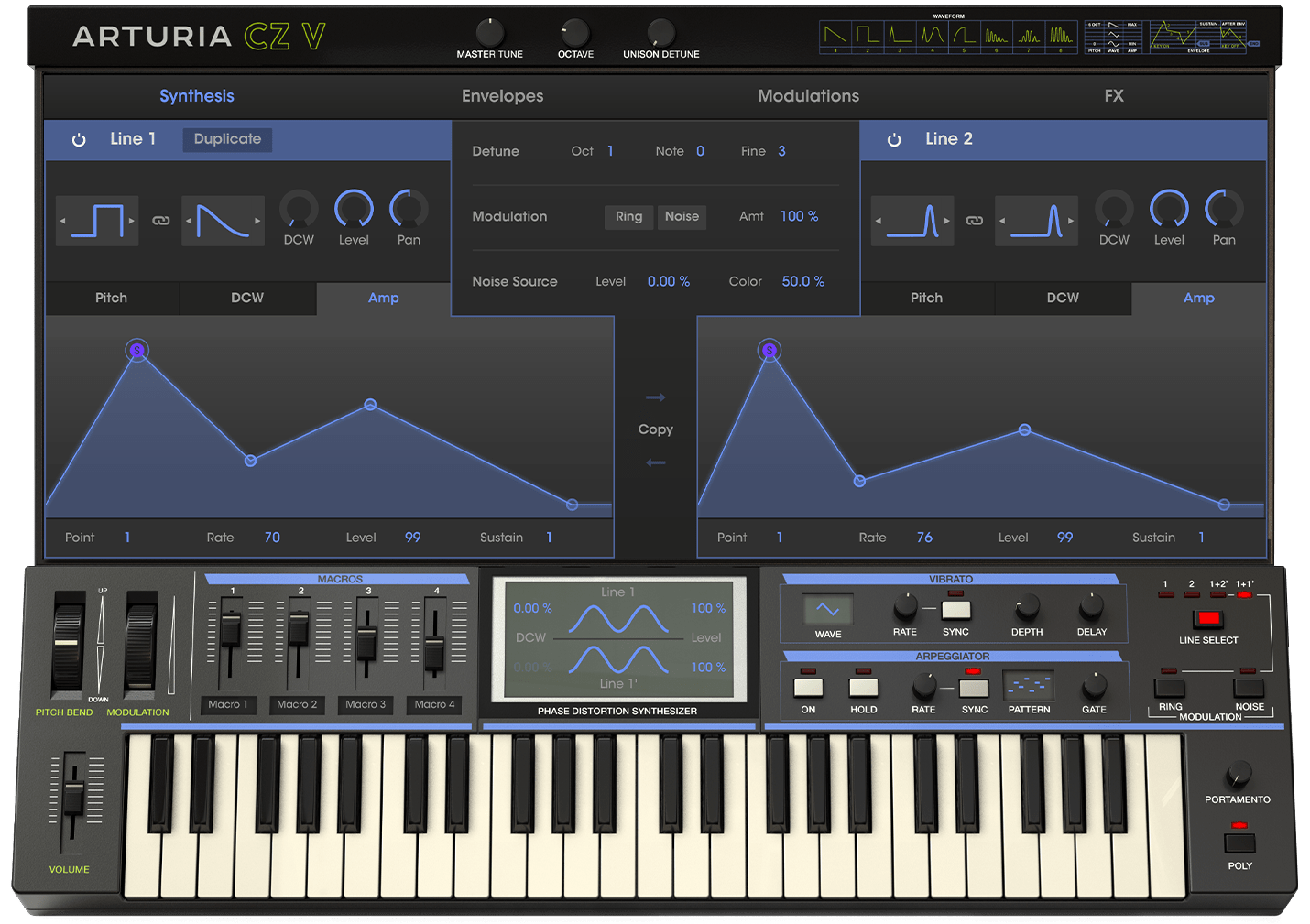
Included in
V collection
Legendary Keyboards Reinvented
This instrument is also part of the V Collection -your complete dream line-up of the legendary synths, organs, pianos and more that made keyboard history. They’re modeled with the most advanced technologies for authentic realism, and enhanced with new creative options. Whether you use it as DAW plugins in the studio or standalone at gigs, V Collection puts the greatest keys of all time at your fingertips for instant inspiration.
Learn More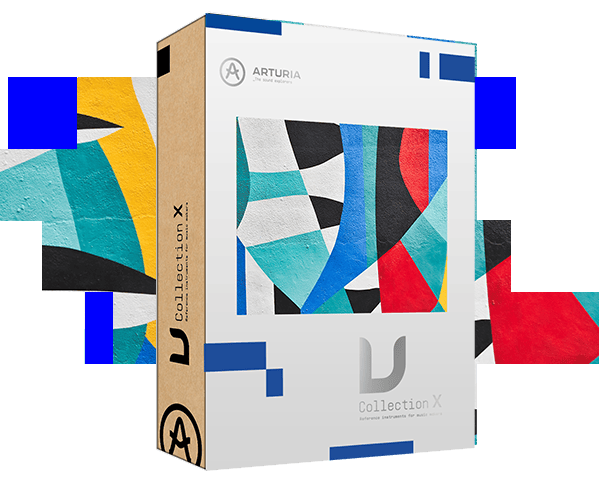
Die Features
Du brauchst

Integrierte In-App-Tutorials führen dich durch jeden Aspekt des Instruments, von individuellen Parametern bis hin zu Tipps unserer Sounddesigner, damit du dich auf deinen kreativen Moment konzentrieren kannst. Das kann doch nicht so einfach sein, ist es aber!

Mit dem Arturia Software Center kannst du deine Arturia Software an einem Ort herunterladen, organisieren und aktualisieren und alle deine Lizenzen für mehrere Geräte verwalten. Einfacher geht es nicht!

Unsere virtuellen Instrumente und Plug-Ins wurden so entwickelt, dass sie problemlos direkt in dein Setup passen. Unabhängig von deinem Style kannst du jeden Sound erkunden und gleichzeitig die volle Kompatibilität mit den wichtigsten DAWs sowohl unter Windows als auch unter macOS genießen.

Finde sofort den richtigen Sound mit dem intelligenten & optimierten Preset-Browser. Suche nach Schlüsselwörtern, nach Instrumentenart, Musikstil und nach vielem mehr - du kannst sogar deine Favoriten speichern, um diese später schnell aufzurufen.

Egal, ob du mit einer Vollbilddarstellung in unsere klassischen Instrumentenemulationen eintauchen oder kostbaren Bildschirmplatz sparen willst – die Bedienoberflächen für alle virtuellen Arturia-Instrumente können beliebig skaliert werden – ganz nach deinem Geschmack.

Unsere Instrumente sind für den nahtlosen Einsatz mit der Arturia KeyLab-Serie vorkonfiguriert - aber sie funktionieren natürlich auch mit anderen MIDI-Controllern. Und mit dabei: Makros für direkte Sound-Optimierung, einfache DAW-Integration und Standalone-Betrieb.
Gallery
Main Features
Two synthesis lines and independent noise source
All CZ-101/CZ-1000 original parameters
8 original waveform and custom waveform editor
Original CZ SysEx import
CZ, DADSR and Multi-Segments envelopes (syncable and loopable) to control pitch, DCW and amplitude
2 Modulation envelopes
4 assignable macros
Advanced modulation matrix
A Sample and Hold module, 2 LFOs with 6 waveforms, 3 sources combinators and an Arpeggiator
4 FXs slots that can be routed in serie or per synthesis line
A synthesis line state viewer for real-time feedback
Emulation of the original CZ DAC
32 voices of polyphony
Up to 8 voices of unison with unison detune
Over 400 factory presets
Platform specifications
Windows
- Win 10+ (64bit)
- 4 GB RAM
- Vierkern-CPU, 3.4 GHz (4.0 GHz Turbo-boost)
- 3GB freier Festplattenspeicher
- OpenGL 2.0 kompatible GPU
- ARM Prozessoren werden unter Windows nicht unterstützt
Systemvoraussetzungen
- Arbeitet als Standalone, VST, AAX, Audio Unit, NKS (nur mit 64-Bit DAWs).





Apple
- Mac OS 11+
- 4 GB RAM
- Vierkern-CPU, 3.4 GHz (4.0 GHz Turbo-boost) oder M1 CPU
- 3GB freier Festplattenspeicher
- OpenGL 2.0 kompatible GPU
Arbeiten mit dem ASC
- Eine elegante und einfache Lösung, die dir bei der Installation, Aktivierung und Aktualisierung der Arturia-Softwareinstrumente hilft.
Alle auf dieser Seite genannten Hersteller- und Produktnamen sind Marken der jeweiligen Eigentümer und stehen in keiner Weise mit Arturia in Verbindung. Die Markenbezeichnungen anderer Hersteller dienen ausschließlich der Kennzeichnung der Produkte derjenigen Hersteller, deren Eigenschaften und Klang bei der Entwicklung analysiert wurden. Alle Namen von Geräten, Entwicklern und Herstellern werden nur zur Veranschaulichung und zu Bildungszwecken aufgeführt und stellen keine Verbindung oder Billigung durch einen Geräte-Entwickler oder -Hersteller dar.




